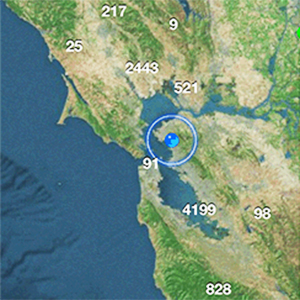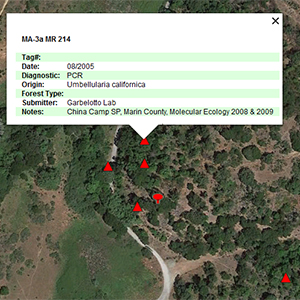When looking at SODmap, you may wonder if P. ramorum-positive trees are close enough to pose a threat to trees on your property. Use the free App SODmap mobile to get the answer. Just tap the App risk function and it will tell you whether infected trees trees are within 200 m (high risk) or 1,000 m (moderate risk). If infected trees are further than 1,000 m, risk is typically low. Alternatively, you can use Google Earth, tapping the icon with a “ruler” on the top bar. Click your mouse on the closest infected tree and then move the mouse to your property. Be careful to actually move the mouse all the way to an oak tree within your property. The mouse should be drawing a line when you go from the infected tree to your oak. When you click the mouse again on top of the oak on your property, the ruler will tell you the distance. The following is suggested:
1- As the crow flies, measure from any infected tree to any oak of interest.
2- Repeat the measurement process using 3 different infected trees that appear to be close to your property.
3- If distance is slightly higher than 200 m (high risk) or 1,000 m (moderate risk), but your property is downhill and/or downwind, you may still consider your oaks to be at risk.
The symptoms on your oak may be caused by a range of issues. If oozing is accompanied by the presence of fine sawdust, then the tree is dying. Even if it is still green you may want to consider removing it if its failure may cause harm to people or property. The fine sawdust is caused by beetles tunneling in the tree. Oaks are only attacked by beetles when dying. If no sawdust is present, then the tree’s condition may be reversible.
Unfortunately, it is difficult to determine what may be the cause of the symptoms you describe. Sudden Oak Death (SOD) can attack an oak tree if California bay laurel is within 60 feet of the oak. You can use the free SODmap Mobile App to determine if you are in a high or moderate risk zone for SOD. To find out how to do that, go to www.sodmapmobile.org. There is also a YouTube video you can watch at https://youtu.be/zE0_q3EmIfs. If the information you gather suggests that it may be SOD, then repeat the phosphite bark application (such as Agri-Fos® combined with Pentra-Bark®) in the fall between October 30th and December 15th. You may also want to consider removal of bays within 30 feet from the oak. Go to http://nature.berkeley.edu/garbelottowp/?page_id=909 to find out about upcoming treatment training sessions to learn more about treatment options. If there are no bays within 60 feet of your oak and the SODmap mobile risk is low, then it likely isn’t SOD.
If you have watered your oak, it may be a root disease such as the oak root fungus or Phytophthora cinnamomi root disease. Make sure you stop watering and expose the upper root system to the air to slow disease progression. If you have never watered your oak, then it may be a secondary disease brought on by the long drought (ex. oak die-back fungus). These are diseases that are strongly affected by the genetics of the tree and weather conditions. In this case, you may want to try watering the tree now and then once again in 2 weeks. Then water once a month starting October 15th. Do not water between July 10th and October 15th. Watering should be done using a low flow approach to ensure that the soil gets wet up to 1 foot down and that no flooding of the tree ever occurs. Unfortunately, if the secondary disease is too advanced, despite all efforts, the tree may still die.
Download sod map mobile and tap the risk button. If the risk shows up as high or moderate, call an arborist listed at http://www.suddenoakdeath.org/diagnosis-and-management/arborists-applicators/. If you get an insufficient data response, then see if you have any CA bay laurel trees within 20 yards of the oak. If you find any, do they have possible P. ramorum (pathogen that causes sudden oak death) symptoms (symptomatic photos: http://www.suddenoakdeath.org/library/photos/plant-symptom-photos/; host information: http://www.suddenoakdeath.org/diagnosis-and-management/hosts-and-symptoms/). If you do find questionable symptoms on bay, again, call an arborist listed at http://www.suddenoakdeath.org/diagnosis-and-management/arborists-applicators/ for a site visit.
Oak testing is routinely done by arborists. It is a rather involved and tedious process that requires a fair amount of finesse and know how as it entails wounding the tree by shaving off the outer layer of bark to collect infected tissue. If you decide to have your oaks tested for SOD, consider going to the Trained Professionals List for arborists that have recently attended an official SOD seminar (Not intended to be a list of recommended professionals, this list does serve as an additional filter when trying to identify arborists that are up-to-date on the latest science-based SOD information.).
Alternatively, a less invasive method of determining the presence or absence of SOD on your property is to sample symptomatic bay leaves (See Hosts and Symptoms for SOD symptoms.). Keep in mind that any infested bay in the general vicinity (typically within 200 ft of an infected oak) may be the inoculum source for infection of your coast live oak. If bay sampling is your preferred method for pathogen detection, you can call your local UC Cooperative Extension office to find out if the California Department of Food and Agriculture is processing leaves from your county and, if so, what the protocol is for sample submissions. In lieu of submitting samples through your county, you can go to www.sodblitz.org to find out when a SOD Blitz will be held in your region (Dates for each year are posted by January 30th. Blitzes typically occur from March to June). Attending a blitz will afford you the opportunity to learn more about SOD, including the latest disease control strategies, during a 1-hour training session. At the end of the session you will be given all sampling materials and instructions for submissions. Blitz participants are free to submit as many leaves as necessary, meaning that you can send in all suspicious leaves from your property as well as from the neighborhood or nearby local parks. All leaves are processed at UC Berkeley and all sampling results are published in a database available at www.sodmap.org or through the free App SODmap mobile.








